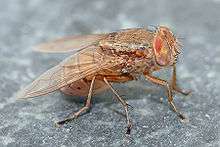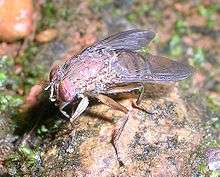Bengalia
Bengalia is a genus of blow flies in the family Calliphoridae with one authority considering the genus to belong to a separate family Bengaliidae.[2] These bristly and, unlike the greens and blues of most calliphorids, dull coloured flies, are especially noted for their relationship to ants. Little is known of their biology and life-cycle, although adults of many species are kleptoparasitic on ants and will snatch food and pupae being carried by ants or feed on winged termites.[3][4][5] The apt name “Highwayman Fly” was given by an early observer of their way of robbing ants.[5] Very little is known about their breeding habits. The genus is found in the Afrotropical and oriental region with one species from Australia possibly a recent introduction.
| Bengalia | |
|---|---|
 | |
| Scientific classification | |
| Kingdom: | Animalia |
| Phylum: | Arthropoda |
| Class: | Insecta |
| Order: | Diptera |
| Family: | Calliphoridae |
| Subfamily: | Calliphorinae |
| Tribe: | Bengaliini |
| Genus: | Bengalia Robineau-Desvoidy, 1830 |
| Type species | |
| Bengalia testacea Robineau-Desvoidy, 1830 (= Bengalia torosa (Wiedemann, 1819)[1] | |
| Species | |
|
>40 species, number in dispute, see text | |
Description
Most of the species have a yellow or brown ground-colour, an antero-posteriorly compressed head, stout mouthparts, a projecting clypeus below the lower facial margin and have a silent flight.

The group (placed at family rank by Lehrer (2005)), has the following morphological characters:[6]
- head very depressed antero-posterior
- eyes elongate
- haustellum is short, large, rigid and has small suction cups and armed with rigid spines and long hairs
- the tergite VI is not visible in continuation of the tergite V, but it is in the interior of tergite VII+VII, like a rudimentary sclerite; the sternite VI forms an incomplete ring formed by fusion of two hemisternites; tergite VII+VIII (the genital tergite) does not result from the fusion of segments VII and VIII, the sternite VII being placed in continuity of the sternite VI and the sternite VIII is the base of the phallosome theca; the sternite IX constitutes the origin of the phallapodema (as in both Calliphoridae and Sarcophagidae); the copulatory organ is derived from tergite IX (as in both Calliphoridae and Sarcophagidae); the anal tergite is the tergite X (as in both Calliphoridae and Sarcophagidae); the sternite X is represented by the "processi longi" or "bacilliform sclerites", which are biarticulated; the paralobes are biarticulated; the phallosome has a distinct and very different configuration from that in the typical Calliphoridae.
Behaviour
Bengalia flies are best known for their remarkable highwayman-like habit of robbing ant pupae from ants moving on ant roads. With respect to Bengalia depressa this habit is described as follows: “[The flies were] settling on blades of grass, stones, and other raised objects near the ant column. ... When any ant made a little circuit away from the main body, a fly would generally pursue it at a distance of about half an inch, but back away as soon as the ant turned towards it. ... Eventually Lamborn saw a fly stalk a minor ant carrying a pupa in its jaws. Suddenly the fly rushed forward and apparently pierced the pupa bringing the ant up with a sharp jerk. The two insects then had a tug of war with very little advantage to either side, until the ant apparently became annoyed and letting go of the pupa rushed at the fly, which escaped with the booty which it proceeded to suck. Then he saw a fly swoop down on the ant column and rise at once with a pupa and attendant ant, both of which it dropped after carrying them for about a foot. The ant, however, still held on and started to run off with its charge. The fly caught it again and this time rose three feet in the air and then dropped ant and pupa again. This time the ant left the pupa which the fly immediately seized and proceeded to suck.”[5]
Species

The following is a partial list of species in the genus:[7][8]
- B. africana Malloch, 1927
- B. aliena Malloch, 1927
- B. asymmetria Kurahashi & Tumrasvin, 1979
- B. bezzii Senior-White, 1923
- B. calilungae Rueda, 1985
- B. chiangmaiensis Kurahashi & Tumrasvin, 1979
- B. chromatella Séguy, 1946
- B. concava Malloch, 1927
- B. cuthbertsoni Zumpt, 1956
- B. depressa Walker, 1858
- B. escheri Bezzi, 1913
- B. fuscipennis Bezzi, 1913
- B. gaillardi Sourcouf & Guyon, 1912 - Synonyms:B. spurca Brauer & Bergenstamm, 1891, B. spurca Villeneuve, 1914
- B. hastativentris Senior-White, 1923
- B. hobbyi Senior-White, 1940
- B. inermis Malloch, 1927
- B. kanoi Kurahashi & Magpayo, 2000
- B. labiata Robineau-Desvoidy, 1830
- B. lyneborgi James, 1966
- B. martinleakei Senior-White, 1930
- B. minor Malloch, 1927
- B. pallidicoxa Senior-White, 1946
- B. peuhi Villeneuve, 1914
- B. pseudovaricolor Kurahashi & Tumrasvin, 1979
- B. recurva Malloch, 1927
- B. robertsi Kurahashi, 1987
- B. roubaudi Rickenbach, Hamon & Mochet, 1960
- B. siamensis Senior-White, 1924
- B. spinifemorata Villeneuve, 1913
- B. spissa Walker, 1858
- B. subnitida James, 1964
- B. surcoufi Senior-White, 1923
- B. taiwanensis Fan, 1965
- B. tibiaria Villeneuve, 1926
- B. unicolor Senior-White, 1946
- B. varicolo Fabricius, 1805
- B. xanthopyga Senior-White, 1924
Taxonomic dispute

The genus was reclassified into 11 new genera in 4 subfamilies by Andy Lehrer in 2005,[9] within a newly designated family, Bengaliidae. The family designation was disputed by Rognes (2006) who noted that it was equivalent to the already established tribe Bengaliini, and that treating it as a family renders the Calliphoridae paraphyletic.[10] Further Rognes considers all the new genera created as junior names for Bengalia.[10] Lehrer's work adds 49 species to the already described 41 species and 18 of these new species are treated as invalid by Rognes. At present, major sources of Dipteran taxonomy do not recognize Lehrer's 10 new genera as valid, nor the 18 new species treated as invalid by Rognes (e.g.[11]).[12]
This dispute reflects that at present, there is no consensus as to the best way to subdivide the Calliphoridae, which many authorities acknowledge is not a natural group (in this case, polyphyletic); the BioSystematic Database of World Diptera, for example, states "The Calliphoridae are marked as a polyphyletic group of convenience as at the present we are unwilling to reduce the Oestridae to a subordinated group within a monophyletic Calliphoridae nor to elevate a number of other groups (Polleniidae, Helicoboscidae, and Bengaliidae) so as to properly delimit both Calliphoridae and Oestridae." Similarly, the dispute at the generic level is that some of Lehrer's genera are paraphyletic, and, additionally, that they are based largely or exclusively upon features of the male genitalia, and it is therefore impossible to identify most female specimens to subfamily, let alone genus[10] (the rejection of Lehrer's subdivisions therefore being both taxonomic and a matter of practicality). The dispute at the species level centers on the fact that Lehrer did not include or examine 24 of the 41 known species in his revision, so of the 31 species he validly described that were not immediately synonymized, many could still potentially be synonyms of these 24 excluded species.[10]
References
| Wikispecies has information related to Bengalia |
- Rognes K (2009). "Revision of the Oriental species of the Bengalia peuhi species-group (Diptera, Calliphoridae)". Zootaxa. 2251: 1–76. doi:10.11646/zootaxa.2251.1.1.
- Lehrer, A.Z., 2003, Bengaliidae n. fam. Une nouvelle famille de Diptera Cyclorrhapha. Entom. Croat., 7(1-2) :5-14
- Sivinski, J., S. Marshall and E. Petersson (1999) Kleptoparasitism and phoresy in the diptera. Florida Entomologist 82(2)
- Bequaert, J. 1922. The predaceous enemies of ants. Bull. Amer. Mus. Nat. Hist 45:27 l-331.
- MELLOR, J. E. M. "NATURAL HISTORY NOTES. Notes on a "Bengalia"-like Fly, Which I Have Called the "Highwayman" Fly, and Its Behaviour towards Certain Species of Ants." Sudan Notes and Records 5, no. 2 (1922): 95-100. https://www.jstor.org/stable/41715637.
- "Archived copy" (PDF). Archived from the original (PDF) on 2014-06-29. Retrieved 2010-04-25.CS1 maint: archived copy as title (link)
- GBIF Archived March 3, 2016, at the Wayback Machine
- Catalogue of life
- Lehrer, A.Z. (2005) Bengaliidae du Monde (Insecta, Diptera). Pensoft Series Faunistica No. 50, Sofia, Moscow. ISSN 1312-0174
- Rognes, K. 2006. Bengalomania – A review of Andy Z. Lehrer's book on Bengalia Robineau-Desvoidy, 1830 and related works (Diptera, Calliphoridae). Studia dipterologica 12: 443–471
- Thompson, F. C. (editor). 2006. Biosystematic Database of World Diptera. Archived November 2, 2007, at the Wayback Machine, accessed on 9 Nov. 2007
- Rognes, K (2011). "Revision of the Bengalia spinifemorata species-group (Diptera, Calliphoridae)". Zootaxa. 2835: 1–29. doi:10.11646/zootaxa.2835.1.1.